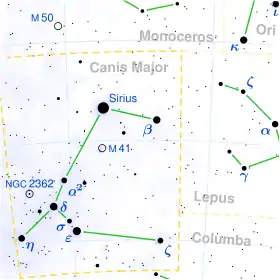Omega Canis Majoris
Omega Canis Majoris, Latinized from ω Canis Majoris, is a solitary,[11] blue-white-hued star in the equatorial constellation of Canis Major. It is visible to the naked eye with an apparent visual magnitude of +4.01.[2] Based upon an annual parallax shift of just 3.58 mas as seen from Earth,[1] this system is located roughly 910 light-years from the Sun.
 | |
| Observation data Epoch J2000.0 Equinox J2000.0 (ICRS) | |
|---|---|
| Constellation | Canis Major |
| Right ascension | 07h 14m 48.65387s[1] |
| Declination | −26° 46′ 21.6097″[1] |
| Apparent magnitude (V) | +4.01[2] |
| Characteristics | |
| Spectral type | B2 IV-Ve[3] |
| U−B color index | −0.73[2] |
| B−V color index | −0.14[2] |
| Astrometry | |
| Proper motion (μ) | RA: −11.88[1] mas/yr Dec.: +6.87[1] mas/yr |
| Parallax (π) | 3.58 ± 0.17[1] mas |
| Distance | 910 ± 40 ly (280 ± 10 pc) |
| Absolute magnitude (MV) | −3.21[4] |
| Details | |
| Mass | 10.1±0.7[5] M☉ |
| Radius | 6.2[6] R☉ |
| Luminosity | 13,081[7] L☉ |
| Surface gravity (log g) | 3.5[8] cgs |
| Temperature | 21,878[8] K |
| Rotational velocity (v sin i) | 80[9] km/s |
| Age | 22.5±2.6[5] Myr |
| Other designations | |
| Database references | |
| SIMBAD | data |
This star has a stellar classification of B2 IV-Ve,[3] indicating it is a Be star showing a mixed spectrum of a main sequence star and a subgiant. One of the most observed Be stars of the Southern Hemisphere,[12] Omega Canis Majoris is classified as a Gamma Cassiopeiae-type variable star.[13] Both the luminosity and the radial velocity vary with a primary cyclical period of 1.372 days.[14] The variation in brightness, ranging from magnitude +3.60 to +4.18,[13] shows changes over time, which suggests there are two overlapping periods of 1.37 and 1.49 days. The star also undergoes transient periodicities following outbursts.[15][9]
This is a massive star with ten[5] times the mass of the Sun and 6.2[6] times the Sun's radius. At an estimated age of 22.5 million years,[5] it is radiating 13,081[7] times the Sun's luminosity from its photosphere at an effective temperature of 21,878 K.[8] The star is being viewed nearly pole on, so the measured projected rotational velocity of 80 km/s is only a fraction of the true equatorial velocity, estimated as 350 km/s. It is surrounded by a symmetric circumstellar decretion disk of material that is being heated by the star, which in turn is inserting emission lines into the combined spectrum.[9]
References
- van Leeuwen, F. (2007), "Validation of the new Hipparcos reduction", Astronomy and Astrophysics, 474 (2): 653–664, arXiv:0708.1752, Bibcode:2007A&A...474..653V, doi:10.1051/0004-6361:20078357.
- Feinstein, A.; Marraco, H. G. (November 1979), "The photometric behavior of Be Stars", Astronomical Journal, 84: 1713–1725, Bibcode:1979AJ.....84.1713F, doi:10.1086/112600.
- Hiltner, W. A.; et al. (July 1969), "MK Spectral Types for Bright Southern OB Stars", Astrophysical Journal, 157: 313–326, Bibcode:1969ApJ...157..313H, doi:10.1086/150069.
- Anderson, E.; Francis, Ch. (2012), "XHIP: An extended hipparcos compilation", Astronomy Letters, 38 (5): 331, arXiv:1108.4971, Bibcode:2012AstL...38..331A, doi:10.1134/S1063773712050015.
- Tetzlaff, N.; et al. (January 2011), "A catalogue of young runaway Hipparcos stars within 3 kpc from the Sun", Monthly Notices of the Royal Astronomical Society, 410 (1): 190–200, arXiv:1007.4883, Bibcode:2011MNRAS.410..190T, doi:10.1111/j.1365-2966.2010.17434.x.
- Underhill, A. B.; et al. (November 1979), "Effective temperatures, angular diameters, distances and linear radii for 160 O and B stars", Monthly Notices of the Royal Astronomical Society, 189: 601–605, Bibcode:1979MNRAS.189..601U, doi:10.1093/mnras/189.3.601
- Hohle, M. M.; et al. (April 2010), "Masses and luminosities of O- and B-type stars and red supergiants", Astronomische Nachrichten, 331 (4): 349, arXiv:1003.2335, Bibcode:2010AN....331..349H, doi:10.1002/asna.200911355.
- Soubiran, C.; et al. (June 2010), "The PASTEL catalogue of stellar parameters", Astronomy and Astrophysics, 515: A111, arXiv:1004.1069, Bibcode:2010A&A...515A.111S, doi:10.1051/0004-6361/201014247.
- Stefl, S.; et al. (February 2010), "The 2008+ outburst of the Be star 28 CMa", in Rivinius, Th.; Curé, M. (eds.), The Interferometric View on Hot Stars, Revista Mexicana de Astronomía y Astrofísica (Serie de Conferencias), 38, pp. 89–91, Bibcode:2010RMxAC..38...89S.
- "ome CMa". SIMBAD. Centre de données astronomiques de Strasbourg. Retrieved 2017-09-03.
- Eggleton, P. P.; Tokovinin, A. A. (September 2008), "A catalogue of multiplicity among bright stellar systems", Monthly Notices of the Royal Astronomical Society, 389 (2): 869–879, arXiv:0806.2878, Bibcode:2008MNRAS.389..869E, doi:10.1111/j.1365-2966.2008.13596.x.
- Ghoreyshi, M. R.; et al. (November 2016), "Modeling the Complete Lightcurve of ω CMa", in Sigut, T. A. A.; Jones, C. E. (eds.), Bright Emissaries: Be Stars as Messengers of Star-Disk Physics, Proceedings of a Meeting held at The University of Western Ontario, in London, Ontario, Canada, 11-13 August 2014, San Francisco: Astronomical Society of the Pacific, p. 315, arXiv:1506.08902, Bibcode:2016ASPC..506..315G.
- Samus, N. N.; et al. (2017), "General Catalogue of Variable Stars", Astronomy Reports, 5.1, 61 (1): 80–88, Bibcode:2017ARep...61...80S, doi:10.1134/S1063772917010085.
- Harmanec, P. (June 1998), "On the nature of the Be phenomenon. I. The case of omega Canis Majoris", Astronomy and Astrophysics, 334: 558–570, Bibcode:1998A&A...334..558H.
- Štefl, S.; et al. (2000), "Tracing the Transient Periods in the Be Star 28 ω CMa", in Smith, Myron A.; Henrichs, Huib F. (eds.), The Be Phenomenon in Early-Type Stars, IAU Colloquium 175, ASP Conference Proceedings, 214, Astronomical Society of the Pacific, p. 240, Bibcode:2000ASPC..214..240S, ISBN 1-58381-045-5.
External links
- Kaler, James B. (March 5, 2010), "OMEGA CMA (Omega Canis Majoris)", STARS, University of Illinois, retrieved 2017-09-05.</ref>